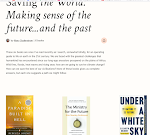Stephen Marche started a bit of a fire storm last week when he blasted the Giller prize list and the current CanLit scene as being stuffy and unoriginal in an article in
The Toronto Star. In essence, he says that this is no country for young men (or women.) Brooklyn, where he’s been based until recently, has a much more exciting literary scene than Toronto.
George Murray posted a link to the story on his
Bookninja.com website, which prompted 65 comments as of this morning, some of them quite thoughtful and some of them plain funny. My own contribution centered on the relatively generous support writers get in Canada from the Canada Council for the Arts and provincial arts councils. Herman Melville, who spent part of his life in Brooklyn, might receive a grant or two if he were writing here and now, but not if he were south of the border, I wrote.
But perhaps Marche is on to something. If he’s arguing that emerging writers sometimes see and say things differently, he may be right.
As it happens, Adam Gopnik, one of those Canadian writers who’ve got elsewhere to seek fame and fortune, (well, actually he was born in the States but grew up in Montreal) has an interesting reflection on writing and creation in the
October 22 New Yorker which talks quite a bit about Melville and
Moby Dick. The British publisher
Orion has just started a series of abridged version of classics, among them Melville’s magnum opus. Gopnik reports that the revised novel reads like a grand adventure. Cut from it, however, are most of the bits about whaling as well as the whole chapter “The Whiteness of the Whale” in which Melville contends that white, “the natural symbol of Good,” is also, “somehow, the natural symbol of Evil.” All the cuts could be justified as moving the story along, making a tighter, more thematically unified work, Gopnik says. But the cuts remove the complexity—perhaps even the genius—from the novel. The “Whiteness” chapter, for example, I remember reading as a meditation on the United States in the decade before the start of the Civil War.
Gopnik goes on: “The real lesson of the campact editions is not that vandals shouldn’t be let loose on masterpieces but that masterpieces are inherently a little loony. They run on the engine of their own accumulated habits and weirdnesses and self-indulgent excesses. They have to, since originality is, necessarily, something still strange to us, rather than something that we already know about and approve. What makes writing matter is not a story, cleanly told, but a voice, however odd or ordinary, and a point of view, however strange or sentimental.”
A little loony, eh? I like that.
It remains to be seen, however, who among our writers—young or old—will be read 100 years from now. Will it be Heather O’Neill’s
Lullabies for Little Criminals (whose heroine—no pun intended—has much in common with the hero of The Adventures of Huckleberry Finn)? She’s 32 and up for the GG and the Hugh MacLennan prizes this fall. Or the many-sided, richly wrought short stories of the formerly young Alice Munro who won her first GG at 37?
It might be worth noting that Melville also was 32 when
Moby Dick was published and that the book did not receive good reviews.
 Elin and Lukas are going to mock me, but I have miniature chocolate bars to give out to the neighborhood kids tonight. When they were growing up, we gave out small boxes of raisins, and the rule was that the two of them could eat as much as they wanted on Halloween night, but the rest was trashed. My idea was that an occasional splurge doesn’t hurt but that weeks of eating candy was bad for teeth and bad for concentration.
Elin and Lukas are going to mock me, but I have miniature chocolate bars to give out to the neighborhood kids tonight. When they were growing up, we gave out small boxes of raisins, and the rule was that the two of them could eat as much as they wanted on Halloween night, but the rest was trashed. My idea was that an occasional splurge doesn’t hurt but that weeks of eating candy was bad for teeth and bad for concentration.
















